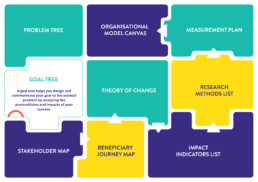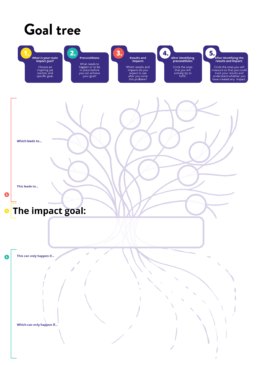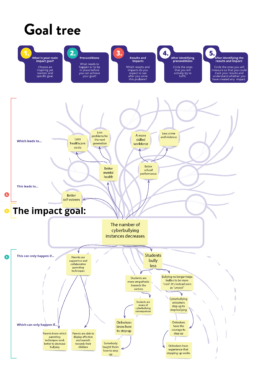Goal Tree

A GOAL TREE helps you design and communicate your solution to the societal problem by analysing the preconditions and impacts of your success.
Tadas Bartasevicius (MB Spanguolės dirbtuvėlės)
I found this tool very beneficial in equally including my team in the decision-making and idea generation processes.
Using the model of the tool, we provide our own activity ideas as solutions to the problems our social business is trying to solve.
Erik Mikkus (Estonian National Youth Council)
I was a guest in a national radio programme and talked about why young candidates aren’t ofter popular in local elections.
The solution tree gave me a systematic approach and clear structure to the issue and helped me prepare for the talk.
What is it?
The goal tree is very similar to the problem tree. It is an easy-to-use tool for specifying what needs to be done to achieve your organisation’s goals and what the impacts are or (hopefully) will be thanks to your success.
This tool helps you understand:
- what you need to be put in place to achieve your goal;
- what good things you can expect to happen if you are successful.
Analysing the first point can help you see what could block you from achieving the goal and solving the problem – so that you could prevent those blockers as early as possible!
The second point helps you understand what can be the impacts if you are successful at achieving your goal. You can use the knowledge of these impacts to communicate the usefulness of achieving your goal and observe if these impacts are really happening when you think you have achieved your goal.
You can watch the video to get an idea of what the tool is about or continue reading after the video player.
In more detail…
1.Write down the goal that you want to achieve as a result of your activities to solve a social problem. If you have already completed a problem tree, you can choose the problem and turn it into a positive goal from that tree. You can also call it your impact goal because achieving this goal means creation of your positive impact too.
2.Write down the preconditions. Imagine working towards the goal and reaching it. What needs to be in place or happen before achieving the goal? What do you need for your plan to work as intended? Is there something you assume to be true, but might not be? For example, getting the preconditions in place may mean tackling some of the root causes of the core problem that you intend to solve or establishing new partnerships to have sufficient resources to achieve the goal.
3.Write down your desired results and impacts, which will occur if you are successful at achieving your goal. What will be the first results that will probably be visible in the shorter term after achieving your goal? What good things can happen thanks to the shorter-term results? Etc.
4.Analyse the goal tree and make choices about your mission and activities. For example, are there any important preconditions that you have not yet ensured? Do you measure the most important results that have been identified thanks to the goal tree?
You can also have variations in its use
Variations in certainty.
LIGHT: Write down the key words based on your (team´s) experience, opinions and gut instinct.
MEDIUM: Involve other organisations, ask for expert opinions, include the viewpoints of the stakeholders that have different experience and values compared with your team.
ADVANCED: Only include causes and consequences that the scientific research and literature has shown to have clear links to the main problem.. E.g. you may think that you may be able to reach certain desired impact by you activities. However, if there have been no studies to prove such possibility, you should not include it to the goal tree.
Why use it?
☑ To make it easier to translate the needs and challenges shown on the problem tree into you impact goal and activities to achieve the goal.
☑ You will better understand what needs to happen before you can achieve your goals. In other words – what are the preconditions that need to be in place before you can be successful. Thanks to this knowledge, you can make efforts to ensure these preconditions. Alternatively, you may decide to identify a new goal if you will see that ensuring the preconditions of your initial goal is not realistic.
☑ You will more precisely identify the results and impacts that will happen thanks to providing your solution, you can communicate the value of your organisation’s work. Also, you may decide to measure at least some of these results and impacts to be sure that achieving your impact goal has really been valuable to the beneficiaries and society.
When to use it?
☑ When developing your impact goals and activities based on the problems that you want to address.
☑ When analysing how you could increase the likelihood of your success by addressing the preconditions of your impact goal. “Addressing the preconditions” means taking action to ensure that these preconditions may be in place.
☑ When analysing whether your impact goals are achievable. If some of the core preconditions cannot be ensured, you should probably change your impact goal into a one in which preconditions can be better met.
☑ When creating indicators that you will use to measure your results and impacts (by identifying all the good things that happen thanks to achieving your impact goal).
☑ When you need to explain your organisation’s work internally or externally, e.g. why you are organising some of the activities (to ensure necessary preconditions of your success) or what the wider value of your organisation´s work is (in case you achieve your impact goal).













